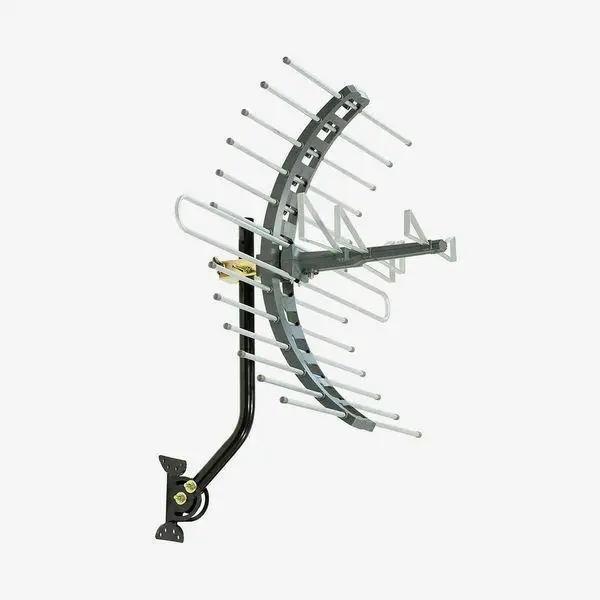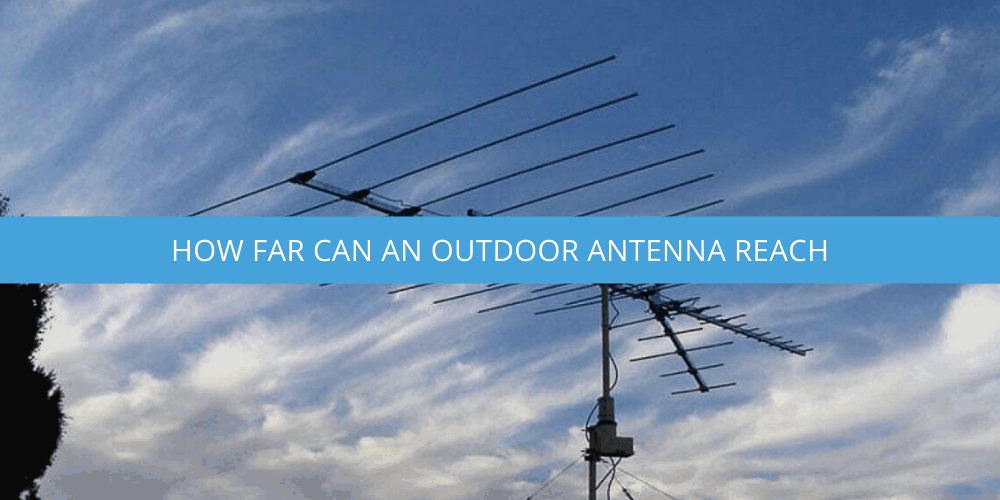The reception of an outdoor antenna is essential for people living in remote areas. Not all antennas can provide the same range.
Factors that can affect the range of an outdoor antenna include the type of signals being transmitted (such as FM, VHF, or UHF), the presence of physical obstructions (such as buildings or mountains), and the presence of electronic interference (such as other electronic devices or power lines).
I will cover this and more in more detail below.

Type Of Antenna And Range
Commercial over-the-air TV antennas with different distance ratings are the norm.
Those antennas are indoor models with a range of 20 to 60 miles. Regarding outdoor models with the highest distance rating, some models offer more than 150 miles. Some real-world conditions must be kept in mind with this range. Thirty-five miles is the distance for ideal reception for a television. This is the perfect distance for good reception with local transmission towers.
Good signal reception can be obtained on televisions about 70 miles away. From this distance onward, the earth’s curvature will begin to be a problem for the signal. OTA reception starts to be affected due to the curvature of the earth and other intervening obstacles. (1)
Even if it is a great TV antenna, you will not get a good signal over 150 miles. Some antennas can provide an acceptable signal level of up to 100 miles or less. Even for that, you need professional installation, some ideal conditions, and luck.
- Yagi-Uda antenna: These antennas are typically used for long-range reception of VHF and UHF signals and can range up to 50 miles or more.
- Bowtie antenna: Bowtie antennas are often used for the reception of UHF signals and can range up to 35 miles.
- Dipole antenna: Dipole antennas are used for the reception of FM signals and can range up to 20 miles.
- Loop antenna: Loop antennas are often used for the reception of AM signals and can range up to 5 miles.
Type of Frequency Effect On Range
Frequencies are divided into two main categories: very high frequency (VHF) and ultra-high frequency (UHF).
VHF frequencies transmit TV channels 2 through 13 and are typically assigned to local stations. In the United States, VHF frequencies range from 54 to 216 MHz.
UHF frequencies transmit TV channels 14 through 69 and are typically assigned to network and cable stations. In the United States, UHF frequencies range from 470 to 890 MHz.
The range of an antenna is typically determined by its ability to receive and amplify weak signals. The specific frequency being transmitted does not directly affect the range of an antenna, but it can impact the antenna’s performance in other ways.
For example, VHF signals tend to travel farther than UHF signals but are also more prone to interference from physical obstructions such as buildings and mountains. This means that an antenna designed to receive VHF signals might have a longer range in some cases, but it might also be more affected by physical obstructions.
On the other hand, UHF signals tend to be more directional and less affected by physical obstructions. This means that an antenna designed to receive UHF signals might have a shorter range in some cases, but it might also be less affected by physical obstructions.
Most TV antennas are designed to receive both VHF and UHF signals
Physical Obstructions Effect On Range
Some common physical obstructions that can affect the signal strength of a TV antenna include:
- Buildings: Large buildings, especially those made of metal or concrete, can block or reflect TV signals, reducing the range and strength of the signal received by the antenna.
- Trees: Depending on their size and location, trees can block or partially obstruct TV signals, resulting in a weaker signal.
- Hills and mountains: These natural features can block TV signals, especially when located between the transmitter and the antenna.
How Can I Extend the Range of My Antenna?
Besides the range of each outdoor antenna, it is possible to take a few simple steps to optimize signal reception.
- Test different locations: You can try various home points to install the antenna for better reception.
- Antenna orientation: The antenna should always be oriented towards the TV transmitting towers.
- Antenna position: The antenna should be positioned horizontally as recommended by experts. This position allows for avoiding obstacles to the same reception of the TV signal.
- To obtain a great height: As the antenna is installed at a greater height, the reception improves considerably.
- Use the best cable: A robust and efficient cable can strengthen the signal. Many people recommend using an RG6 coaxial cable. This will enable it to take care of the signal received by the antenna, which arrives with high efficiency.
Does Aluminum Foil Improve Radio Reception?
Aluminum foil, which is very common for any home, can optimize the reception. It is not a 100% effective method, although it can help the range of each antenna. It can function as an excellent mirror on the radio wave frequency as this foil material is an excellent conductor. (2)
There may be a blockage that prevents the antenna transmitter. The aluminum foil reflects in the line of sight, allowing a result more in line with the expectations of each user. This same aluminum foil can block interference from other transmitters.
How to Choose the Proper Outdoor Antenna Range?

The distance of a home from the local broadcast towers should be considered. Considering the actual space, some TV antenna options with higher mileage ratings should be chosen. It is essential not to exceed the mileage rating of a TV antenna. This could lead to tuner saturation by sending too strong a signal to each TV set.
Can Interference from other antennas reduce range?
Interference from other TV antennas can potentially affect the range and performance of your antenna, especially if the other antennas are located close by. Interference can occur when two or more antennas receive or transmit signals on the same or adjacent frequencies, which can cause the signals to interfere. This can result in a weaker or distorted signal or some cases, no signal.
There are a few ways that interference from other TV antennas can impact your antenna’s range and performance:
- Signal overload: If the other antenna is transmitting a strong signal on the same frequency as your antenna, it can overload your antenna’s amplifier, causing it to receive a weaker or distorted signal.
- Co-channel interference: If the other antenna is transmitting a signal at the same frequency as your antenna, it can interfere with your antenna’s ability to receive the desired signal.
- Adjacent channel interference: If the other antenna is transmitting a signal on a frequency adjacent to the one your antenna is trying to receive, it can interfere with your antenna’s ability to pick up the desired signal.
There are a few ways to mitigate interference from other antennas. One option is to use an antenna with a directional pattern, which can help to focus the signal in a specific direction and reduce interference from other sources. Another option is to use a high-gain antenna, which can amplify the desired signal and help reduce the impact of interference. In some cases, changing the frequency or channel your antenna is tuned to may also be possible, which can help avoid interference from other sources.
References(1) OTA – https://searchmobilecomputing.techtarget.com/definition/OTA-update-over-the-air-update(2) Aluminum foil – https://www.sciencedirect.com/topics/materials-science/aluminum-foil

